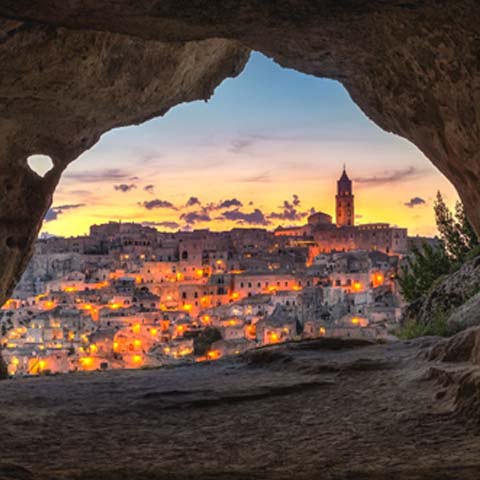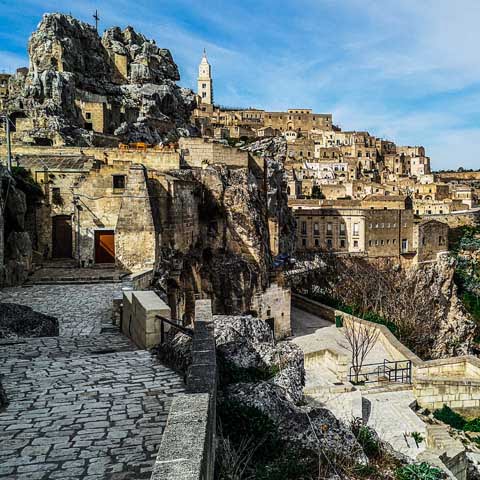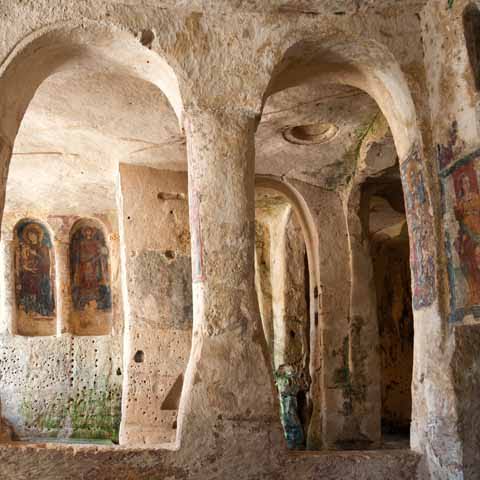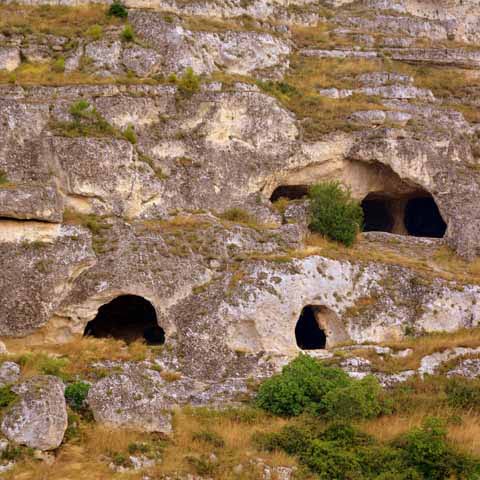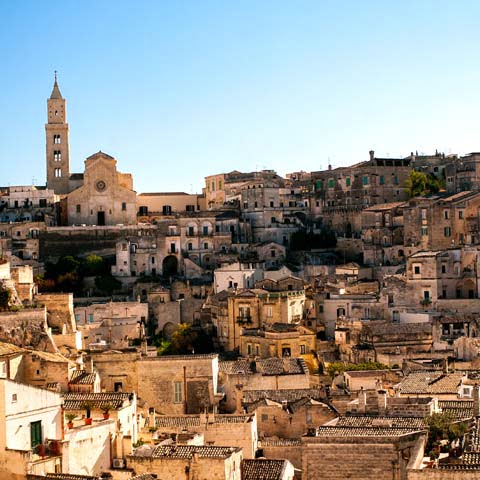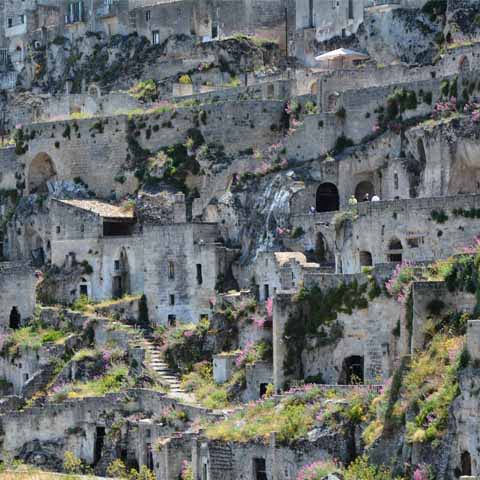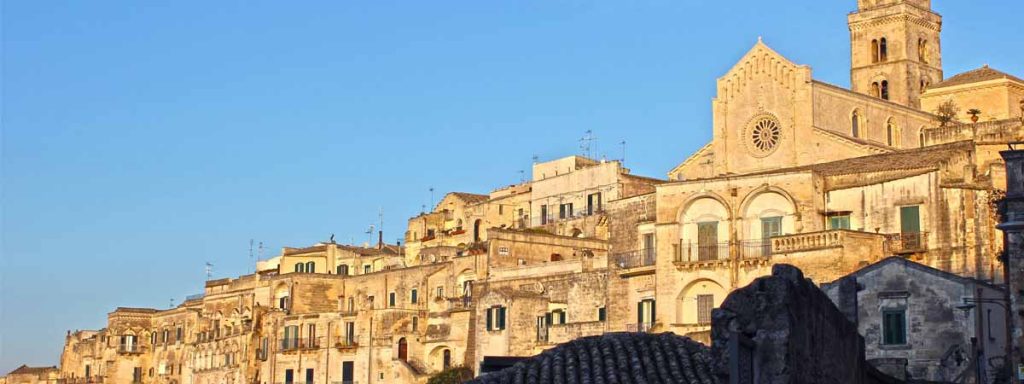Matera is a peculiar town in the Basilicata region, located on the western slope of the Murgia Plateau. Its picturesque position, on the edge of Gravina di Matera River that descends towards the Bradano River, has inspired travelers and artists throughout the centuries. But it also constituted a naturally defended location for the prehistoric civilizations who first settled the area.
The town is divided into two parts, an ancient one, located on the steep edge of a deep ravine, and a modern one which extends over the W-shaped plateau. Prehistoric Matera, also called Matera dei Sassi, constitutes the heart of the old town and includes the characteristic complexes of Sasso Barisano to the north and Sasso Caveoso to the south, divided by the rocky headland of the Civita district.
The modern urban arrangement is set on straight-line arteries diverging in a sort of a fan from the historic city center.
Between 1952 and 1960, the Sassi were evicted and abandoned for decades during an effort to revitalize the local area. In 1993, UNESCO declared the area a World Heritage Site and renown for the town’s unique beauty grew. Today, the two Sassi of Matera are subject to a program aimed at preservation and conservation and attract travelers from all over the world.
Due to the peculiar aspect of the old town and the exceptional state of the cave settlements, Matera is an important cultural center and has been featured in many films over the years, including Mel Gibson’s The Passion of the Christ and Wonder Woman.
PREHISTORY OF MATERA
Matera is considered one of the oldest cities in the world, and archaeological research conducted on the territory attributes the first human settlements in the area to the Paleolithic eras. The first populations to settle in this space were probably made up of nomadic hunters, followed by primitive shepherds who settled in the areas of Murgia Timone and Murgecchia, including the hills of today’s Civita district.
These areas were preferred over the others because of their easy access to water of the small Lake Jurio. In this environment, the first peoples inhabited the existing caves, then proceeded to dig new caves into the rocks to accommodate a growing population.
During the Neolithic age, the settlements became more stable according to traces of several entrenched villages. But the first permanent urban nucleus in Matera was born only in the Iron Age, in the current area of Civita, on the right bank of the Gravina River.
Due to the peculiarity of the environment, located far from the large inhabited centers, the centuries passed with few exceptional events, promoting a singular continuity of life. This is testified by the prehistoric stratifications studied by Domenico Ridola in the early twentieth century.
Moreover, excavations carried out near the Cathedral of Matera highlighted the various periods of the prehistory of the city.
In addition to this stratigraphic documentation, the prehistoric and historical events in Matera are told by the abundant testimonies gathered in the National Archaeological Museum Domenico Ridola, where findings from the lower Paleolithic, and important artifacts from Greek and Roman times are exhibited.
Matera is suspected to have reached its current appearance when the first Greek colonies settled in the region and the city maintained close relations with the other Greek colonies located on the Adriatic coast.
The Greeks gave the name to the settlement, calling it Mataia Ole, a name deriving from Mataio Olos and meaning “all vacuous,” with reference to Gravina. However, other hypotheses suggest the name derives from Mata, meaning a pile of rocks. Regardless of the hypothesis, it is clear that the name has Greek origins.
HISTORY OF MATERA
The Roman dominion arrived in Matera in 272 BC and lasted for an extensive period, although it did not leave exceptional traces behind. For Rome, Matera was only a supply and transit center devoid of any strategic relevance.
Due to this reason, the Roman times brought more destruction than prosperity to the city, including the destruction of ancient monasteries followed by the subsequent closure of other centers, facts that helped to disperse evidence of great value from the earliest history.
Perhaps these facts explain the large gaps in the historical information related to the Roman period before the eleventh century AD.
However, according to a few remaining documents, after the fall of the Western Roman Empire in the second half of the sixth century, Matera passed to the Longobards, followed by the Byzantines in 612. Neither the first Longobard domination nor the Byzantine domination left particular marks on the city.
In 664, the Longobards conquered Matera again, and the city became part of the Duchy of Benevento, where it remained for the upcoming centuries. But in 867 the Longobards, harassed by the Saracens, asked for the intervention of Emperor Louis II, who decided to set Matera on fire in an attempt to fight back against the Saracens, with the intention to rebuild it later.
But the attempt was not exactly successful, and the city suffered from numerous raids of the Saracens. Sought by Salerno and conquered by Otto II, Matera was assigned to the Duchy of Benevento again. Matera was later conquered by the Greeks in 978.
In 994, a disastrous earthquake razed what was left of the city to the ground.
At the beginning of the eleventh century, with the instauration of the Norman domination, Matera was proclaimed an independent state located at the center of vast lands and numerous castles. The first count to establish power in the region was William the Norman, in 1043, followed by the dynasty of Altavilla.
Under the command of Robert Guiscard, the crusaders left Castiglione engaging in battles for the liberation of the Holy Sepulcher. Taking advantage of the events and those faithful to Frederick II, Matera adapted to the dominion of the Anjou, although reluctantly, hoping for a truce under the Aragon.
In fact, the Aragon formally promised to keep Matera in direct dependence, but the rulers often fell short of the commitments made, with the most serious consequences caused by the sale of the settlement to Count Giancarlo Tramontano.
This decision caused social uprisings and riots that ended with Tramontano’s death in 1514.
The upcoming century was characterized by an alternation of periods of independence with various events of redemption and sale. But in the middle of these events, in 1663 Matera, which at the time was part of Terra d’Otranto, was chosen as the seat of the Royal Hearing of Basilicata and aggregated to this region.
Matera remained capital of Basilicata until 1806, when Giuseppe Bonaparte transferred regional competence, thus the power, to Potenza. From this moment on, the history of Matera is negligible until the first half of the twentieth century.
In 1927, Matera was nominated capital of the province with the same name, gaining administrative authority over 31 municipalities, but the principal role in the region was still assigned to Potenza.
During World War II, Matera was the first city in Southern Italy to rise against the Nazis, events that drew serious consequences. On September 21, 1943, ten locals were executed by the retreating German troops, causing a popular revolt which ended with a further loss for the city. In total, 22 inhabitants of Matera lost their lives that day.
In the post war period, the local council started to raise the question of the Sassi di Matera. In fact, the Sassi were seen as rudimentary dwellings, while the increasing urban density, the crisis of pastoralism, and the peripheral context played by the entire south in the post war years led to a continuous deterioration of the quality of life of the inhabitants of the old cave houses.
The extension of the city and the erection of new homes also took their toll on the situation by further reducing the water supply to the Sassi district. The increase in the population caused numerous other problems, and due to the nature of the territory, the
administration found it impossible to implement a proper water pipeline and sewage system in the prehistoric heart of the city.
The situation in Matera was so critical that Carlo Levi described the settlement as primitive in his iconic memoir Cristo si è fermato a Eboli.
The conditions of life were now on the verge of collapse, as evidenced by the high infant mortality. But Levi’s masterpiece drew the attention of many men of culture and politicians, including Alcide de Gasperi, Italy’s Prime Minister, who visited Matera in 1952 and signed, two years later, the Special Law for the displacement of the Sassi.
In accordance with the new regulations, two-thirds of the dwellers were forced to abandon their homes and move to new districts. This was the first time in the world that a government forced people out of their dwellings due to the impossibility of building proper utilities, and the displacement involved sociologists, anthropologists, urban planners, and architects who were asked to design the new districts for the over 15,000 displaced people.
Matera adopted the regulatory plan and followed it to the letter. New districts were built according to a “Scandinavian model” around the prehistoric center, and in only fifteen years all the people were moved from the cave dwellings to modern homes.
As a result of the events, the Sassi were completely abandoned, and it was declared illegal to live in the rudimentary houses. Moreover, in exchange for the new home, for which the receiver paid drastically low rent, the corresponding dwelling was expropriated, becoming property of the state.
With the laws preventing anyone from living in the old center, Matera became a lively city with a completely dead historic center. In fact, the Sassi were defined as the largest completely abandoned historic center in the world.
After decades of neglect, in 1986 a new national law provided finance for the recovery of the ancient districts, and the intense process of recovery in Matera began. Due to the exceptional work carried out and to the uniqueness of the territory, in 1993, the Sassi of Matera were declared a UNESCO World Heritage Site. Today, Matera’s historic city center with its ancient cave dwellings is considered to be one of the most unique travel destinations in Italy.
ARCHAEOLOGY OF MATERA
Archaeology is well represented in Matera, and there are many testimonies from the earliest prehistoric times. An extensive, open-air archeological area is located in the area of the Sassi, preserving the original cave dwellings abandoned in the second half of the twentieth century.
Apart from the Sassi, the territory of Matera is scattered with necropolises, rudimentary churches, and other archaeologically important monuments.
The National Archaeological Museum Domenico Ridola established in 1911 is particularly noteworthy. Exhibiting important collections, the museum houses impressive artifacts found in the area of Matera. The exhibition follows a chronological and topographical order and goes from the prehistoric section that holds significant findings from the Neolithic to the later stages defined by the introduction of agriculture and the instauration of stable settlements.
Among the exhibits, there are a series of funerary objects and monumental vases, votive statuettes and other objects found in a sacred area.
Numerous Sassi dwellings have been transformed into museums. These experiences allow a full immersion into the traditional lifestyle of the dwellers in an attempt to understand their habits and way of life.
The Museum of the Peasant Civilization is an anthropological museum that offers additional insight into the local lifestyle, highlighting the connection between the people and the land.
Don't just see Italy, live it.
Your dream trip to Italy has never been closer
No more endlessly scrolling travel sites. Our travel experts will craft the perfect, one-of-a-kind trip just for you.

300+
DESTINATIONS
We offer more Italian destinations than any travel site. Do and see more with Trips 2 Italy.
1 (of a kind)
ITINERARIES
Because your dream trip to Italy should be designed for you, not for the masses.
100%
PEACE OF MIND
From flights and accommodations, to food and activities - we take care of every detail.
